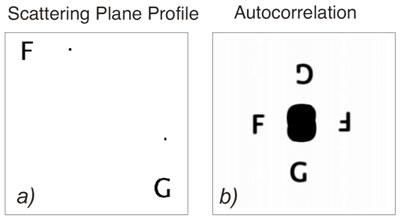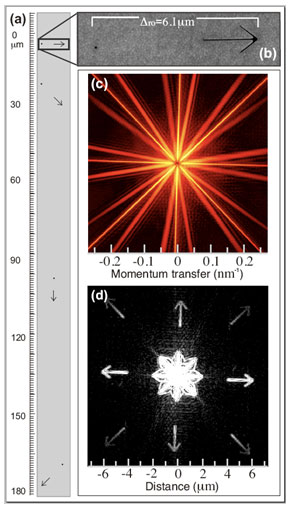
Panoramic images are captivating in any form, be it of a city sky line or a mosaic of micrographs. They feature a wide field of view and uncompromised resolution. Forming such extraordinary images can be achieved with oversized film or by stitching together smaller images. But these options are not always practical for microscopy with x-rays especially for imaging with ultrashort pulses of x-rays. We have demonstrated a new holographic technique, called extended field of view Fourier transform holography (FTH), for imaging isolated areas of a nanoscale sample without compromising spatial resolution. This technique overcomes one of the central challenges in imaging, namely to simultaneously obtain high spatial resolution and a large field of view. The method is compatible with single shot imaging—a feature particularly important for studying dynamics at upcoming X-ray free electron lasers like the Linac Coherent Light Source (LCLS) at SLAC.
In FTH, the light scattered from a coherently illuminated sample object and reference source is detected as a far field diffraction pattern or hologram. [Eisebitt] To reconstruct the image, the spatial Fourier transformation of the hologram is calculated. An image of the sample object is embedded in the result of the calculation, which is called the autocorrelation. The position and field of view of the image within the autocorrelation is controlled by the respective placement of the reference source and extent of the object. To extend the field of view our method applies multiple objects and reference sources to x-ray Fourier transform holography. The key is the strategic arrangement of the reference and object structures such that the individual images tile without overlapping in the autocorrelation as explained in Fig 1.

But this concept is not new, it was realized first at Stanford over 50 years ago using visible wavelengths as a method to improve holographic images distorted by atmospheric disturbances. [Goodman] Though fluctuations in the atmosphere blur images of distant objects it is the finite size of the pixels in a x-ray detector that blur the spatial resolution of a hologram. However, because the holograms represent reciprocal space the blurring translates to a smaller field of view in the real space reconstruction. By strategically arranging holographic references on the sample the effective field of view can be extended, thus circumventing the smearing caused by the detector.
To test the LCLS readiness of our method, we used the soft x-ray coherent scattering beamline at SSRL, which is now Beamline 13-3. Our sample is a nanostructured 1 µm thick Au film supported by the silicon nitride membrane shown in Fig 2(a). Four isolated arrow shaped structures were milled through the soft x-ray opaque film, and next to each arrow is a strategically placed reference, see Fig 2(b). The entire structure, which spans 180 µm, was illuminated with a spatially coherent soft x-ray beam (lambda=1.58nm) to generate the hologram in Fig. 2(c). The Fourier reconstruction in Fig. 2(d) shows that all four arrows are imaged at a resolution set by the size of the reference source, ~50nm. Since there is a unique relationship between each arrow on the mask, the specific arrow or region of the sample can be identified in the reconstruction.
In addition to demonstrating extended field of view FTH this experiment can be used to envision a novel method for recording the evolution of ultrafast processes. This method will be enabled by x-ray free electron laser sources like the LCLS. Just one of the ultrashort x-ray pulses generated by the LCLS is bright enough to acquire an entire hologram. As a result the entire ultrafast temporal response across different locations on the sample can to be captured simultaneously. But recording the response of the sample is only part of the method, the sample must also be synchronously excited.
Cross-beam pump-probe experiments exploit the angle between an excitation (pump) pulse and a readout (probe) pulse to map temporal dynamics onto the extent of a sample. [Lindenberg] In this way, spatial images can record temporal dynamics, and thus the temporal resolution is limited by the spatial resolution. We therefore envision applying the cross-beam geometry to spatially multiplexed FTH as depicted in Fig. 3. The pump pulse sweeps across the sample exciting it while the probe, x-ray pulse, captures the evolution after excitation. Because of the geometry of this holographic mask the temporal evolution follows the arrows like the hand on an ultrafast stopwatch. Using this realistic geometry it is possible to study sub-femtosecond dynamics over a picosecond timescale.
Robust experimental techniques are essential to make meaningful measurements at x-ray free electron lasers. The advanced sample preparation for extended field of view FTH assures experimental success for ultrafast dynamics at an FEL.

S. Eisebitt, et al., Nature, 432 pp 885-887, 2004
J. W. Goodman and J. D. Gaskill, Proc. IEEE 57, 823 (1969)
A. M. Lindenberg et al., Science 308, 392 (2005)
W. F. Schlotter, J. Lüning, R. Rick, K. Chen, A. Scherz, S. Eisebitt, C. M. Günther, W. Eberhardt, O. Hellwig, J. Stöhr, "Extended field of view soft x-ray Fourier transform holography: toward imaging ultrafast evolution in a single shot" Optics Letters, 32 (21) p3110 (2007)




